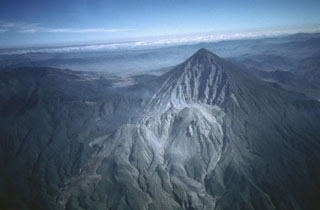Report on Santa Maria (Guatemala) — March 1997
Bulletin of the Global Volcanism Network, vol. 22, no. 3 (March 1997)
Managing Editor: Richard Wunderman.
Santa Maria (Guatemala) Reports of 6 February dome collapse proven false
Please cite this report as:
Global Volcanism Program, 1997. Report on Santa Maria (Guatemala) (Wunderman, R., ed.). Bulletin of the Global Volcanism Network, 22:3. Smithsonian Institution. https://doi.org/10.5479/si.GVP.BGVN199703-342030
Santa Maria
Guatemala
14.757°N, 91.552°W; summit elev. 3745 m
All times are local (unless otherwise noted)
Reports of a significant dome collapse at Santiaguito on 6 February were proven false during investigations conducted by geologists from the Instituto Nacional de Sismología, Vulcanología, Meteorología e Hydrología (INSIVUMEH). It is likely that minor downslope movement of loose debris near the summit caused the report.
At 1900 and 2100 on 11 February, local residents from farms S of the dome saw a significant dacitic lava flow.
Geological Summary. Symmetrical, forest-covered Santa María volcano is part of a chain of large stratovolcanoes that rise above the Pacific coastal plain of Guatemala. The sharp-topped, conical profile is cut on the SW flank by a 1.5-km-wide crater. The oval-shaped crater extends from just below the summit to the lower flank, and was formed during a catastrophic eruption in 1902. The renowned Plinian eruption of 1902 that devastated much of SW Guatemala followed a long repose period after construction of the large basaltic andesite stratovolcano. The massive dacitic Santiaguito lava-dome complex has been growing at the base of the 1902 crater since 1922. Compound dome growth at Santiaguito has occurred episodically from four vents, with activity progressing E towards the most recent, Caliente. Dome growth has been accompanied by almost continuous minor explosions, with periodic lava extrusion, larger explosions, pyroclastic flows, and lahars.
Information Contacts: Otoniel Matías, INSIVUMEH, Guatemala; Barry Cameron and Shane Rundle, Northern Illinois University, USA.

